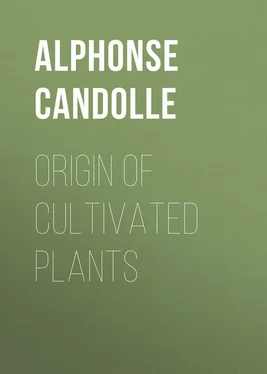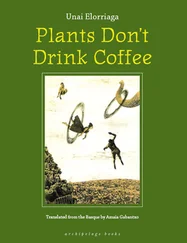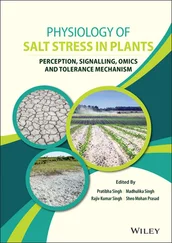Alphonse Candolle - Origin of Cultivated Plants
Здесь есть возможность читать онлайн «Alphonse Candolle - Origin of Cultivated Plants» — ознакомительный отрывок электронной книги совершенно бесплатно, а после прочтения отрывка купить полную версию. В некоторых случаях можно слушать аудио, скачать через торрент в формате fb2 и присутствует краткое содержание. Жанр: foreign_antique, foreign_prose, на английском языке. Описание произведения, (предисловие) а так же отзывы посетителей доступны на портале библиотеки ЛибКат.
- Название:Origin of Cultivated Plants
- Автор:
- Жанр:
- Год:неизвестен
- ISBN:нет данных
- Рейтинг книги:4 / 5. Голосов: 1
-
Избранное:Добавить в избранное
- Отзывы:
-
Ваша оценка:
- 80
- 1
- 2
- 3
- 4
- 5
Origin of Cultivated Plants: краткое содержание, описание и аннотация
Предлагаем к чтению аннотацию, описание, краткое содержание или предисловие (зависит от того, что написал сам автор книги «Origin of Cultivated Plants»). Если вы не нашли необходимую информацию о книге — напишите в комментариях, мы постараемся отыскать её.
Origin of Cultivated Plants — читать онлайн ознакомительный отрывок
Ниже представлен текст книги, разбитый по страницам. Система сохранения места последней прочитанной страницы, позволяет с удобством читать онлайн бесплатно книгу «Origin of Cultivated Plants», без необходимости каждый раз заново искать на чём Вы остановились. Поставьте закладку, и сможете в любой момент перейти на страницу, на которой закончили чтение.
Интервал:
Закладка:
Origin of Cultivated Plants The International Scientific Series Volume XLVIII
AUTHOR’S PREFACE
The knowledge of the origin of cultivated plants is interesting to agriculturists, to botanists, and even to historians and philosophers concerned with the dawnings of civilization.
I went into this question of origin in a chapter in my work on geographical botany; but the book has become scarce, and, moreover, since 1855 important facts have been discovered by travellers, botanists, and archæologists. Instead of publishing a second edition, I have drawn up an entirely new and more extended work, which treats of the origin of almost double the number of species belonging to the tropics and the temperate zones. It includes almost all plants which are cultivated, either on a large scale for economic purposes, or in orchards and kitchen gardens.
I have always aimed at discovering the condition and the habitat of each species before it was cultivated. It was needful to this end to distinguish from among innumerable varieties that which should be regarded as the most ancient, and to find out from what quarter of the globe it came. The problem is more difficult than it appears at first sight. In the last century and up to the middle of the present authors made little account of it, and the most able have contributed to the propagation of erroneous ideas. I believe that three out of four of Linnæus’ indications of the original home of cultivated plants are incomplete or incorrect. His statements have since been repeated, and in spite of what modern writers have proved touching several species, they are still repeated in periodicals and popular works. It is time that mistakes, which date in some cases from the Greeks and Romans, should be corrected. The actual condition of science allows of such correction, provided we rely upon evidence of varied character, of which some portion is quite recent, and even unpublished; and this evidence should be sifted as we sift evidence in historical research. It is one of the rare cases in which a science founded on observation should make use of testimonial proof. It will be seen that this method leads to satisfactory results, since I have been able to determine the origin of almost all the species, sometimes with absolute certainty, and sometimes with a high degree of probability.
I have also endeavoured to establish the number of centuries or thousands of years during which each species has been in cultivation, and how its culture spread in different directions at successive epochs.
A few plants cultivated for more than two thousand years, and even some others, are not now known in a spontaneous, that is, wild condition, or at any rate this condition is not proved. Questions of this nature are subtle. They, like the distinction of species, require much research in books and in herbaria. I have even been obliged to appeal to the courtesy of travellers or botanists in all parts of the world to obtain recent information. I shall mention these in each case with the expression of my grateful thanks.
In spite of these records, and of all my researches, there still remain several species which are unknown wild. In the cases where these come from regions not completely explored by botanists, or where they belong to genera as yet insufficiently studied, there is hope that the wild plant may be one day discovered. But this hope is fallacious in the case of well-known species and countries. We are here led to form one of two hypotheses; either these plants have since history began so changed in form in their wild as well as in their cultivated condition that they are no longer recognized as belonging to the same species, or they are extinct species. The lentil, the chick-pea, probably no longer exist in nature; and other species, as wheat, maize, the broad bean, carthamine, very rarely found wild, appear to be in course of extinction. The number of cultivated plants with which I am here concerned being two hundred and forty-nine, the three, four, or five species, extinct or nearly extinct, is a large proportion, representing a thousand species, out of the whole number of phanerogams. This destruction of forms must have taken place during the short period of a few hundred centuries, on continents where they might have spread, and under circumstances which are commonly considered unvarying. This shows how the history of cultivated plants is allied to the most important problems of the general history of organized beings.
Geneva, 1882.
PART I.
General Remarks
CHAPTER I.
IN WHAT MANNER AND AT WHAT EPOCHS CULTIVATION BEGAN IN DIFFERENT COUNTRIES
The traditions of ancient peoples, embellished by poets, have commonly attributed the first steps in agriculture and the introduction of useful plants, to some divinity, or at least to some great emperor or Inca. Reflection shows that this is hardly probable, and observation of the attempts at agriculture among the savage tribes of our own day proves that the facts are quite otherwise.
In the progress of civilization the beginnings are usually feeble, obscure, and limited. There are reasons why this should be the case with the first attempts at agriculture or horticulture. Between the custom of gathering wild fruits, grain, and roots, and that of the regular cultivation of the plants which produce them, there are several steps. A family may scatter seeds around its dwelling, and provide itself the next year with the same product in the forest. Certain fruit trees may exist near a dwelling without our knowing whether they were planted, or whether the hut was built beside them in order to profit by them. War and the chase often interrupt attempts at cultivation. Rivalry and mistrust cause the imitation of one tribe by another to make but slow progress. If some great personage command the cultivation of a plant, and institute some ceremonial to show its utility, it is probably because obscure and unknown men have previously spoken of it, and that successful experiments have been already made. A longer or shorter succession of local and short-lived experiments must have occurred before such a display, which is calculated to impress an already numerous public. It is easy to understand that there must have been determining causes to excite these attempts, to renew them, to make them successful.
The first cause is that such or such a plant, offering some of those advantages which all men seek, must be within reach. The lowest savages know the plants of their country; but the example of the Australians and Patagonians shows that if they do not consider them productive and easy to rear, they do not entertain the idea of cultivating them. Other conditions are sufficiently evident: a not too rigorous climate; in hot countries, the moderate duration of drought; some degree of security and settlement; lastly, a pressing necessity, due to insufficient resources in fishing, hunting, or in the production of indigenous and nutritious plants, such as the chestnut, the date-palm, the banana, or the breadfruit tree. When men can live without work it is what they like best. Besides, the element of hazard in hunting and fishing attracts primitive, and sometimes civilized man, more than the rude and regular labour of cultivation.
I return to the species which savages are disposed to cultivate. They sometimes find them in their own country, but often receive them from neighbouring peoples, more favoured than themselves by natural conditions, or already possessed of some sort of civilization. When a people is not established on an island, or in some place difficult of access, they soon adopt certain plants, discovered elsewhere, of which the advantage is evident, and are thereby diverted from the cultivation of the poorer species of their own country. History shows us that wheat, maize, the sweet potato, several species of the genus Panicum, tobacco, and other plants, especially annuals, were widely diffused before the historical period. These useful species opposed and arrested the timid attempts made here and there on less productive or less agreeable plants. And we see in our own day, in various countries, barley replaced by wheat, maize preferred to buckwheat and many kinds of millet, while some vegetables and other cultivated plants fall into disrepute because other species, sometimes brought from a distance, are more profitable. The difference in value, however great, which is found among plants already improved by culture, is less than that which exists between cultivated plants and others completely wild. Selection, that great factor which Darwin has had the merit of introducing so happily into science, plays an important part when once agriculture is established; but in every epoch, and especially in its earliest stage, the choice of species is more important than the selection of varieties.
Читать дальшеИнтервал:
Закладка:
Похожие книги на «Origin of Cultivated Plants»
Представляем Вашему вниманию похожие книги на «Origin of Cultivated Plants» списком для выбора. Мы отобрали схожую по названию и смыслу литературу в надежде предоставить читателям больше вариантов отыскать новые, интересные, ещё непрочитанные произведения.
Обсуждение, отзывы о книге «Origin of Cultivated Plants» и просто собственные мнения читателей. Оставьте ваши комментарии, напишите, что Вы думаете о произведении, его смысле или главных героях. Укажите что конкретно понравилось, а что нет, и почему Вы так считаете.











